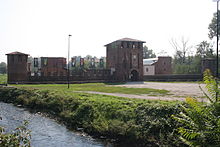Legnano
Legnano | |
|---|---|
| Comune di Legnano | |
 | |
 Legnano within the Province of Milan | |
| Coordinates: 45°36′N 08°55′E / 45.600°N 8.917°E | |
| Country | Italy |
| Region | Lombardy |
| Metropolitan city | Milan (MI) |
| Government | |
| • Mayor | Gianbattista Fratus |
| Area | |
| • Total | 17 km2 (7 sq mi) |
| Elevation | 199 m (653 ft) |
| Population (30 November 2011)[2] | |
| • Total | 60,282 |
| • Density | 3,500/km2 (9,200/sq mi) |
| Demonym | Legnanesi |
| Time zone | UTC+1 (CET) |
| • Summer (DST) | UTC+2 (CEST) |
| Postal code | 20025 |
| Dialing code | 0331 |
| Patron saint | St. Magnus |
| Saint day | November 5 |
| Website | Official website |
Legnano [leɲˈɲaːno] (Template:Lang-lmo) is an Italian town and comune with 60,282 inhabitants in the north-westernmost part of the Metropolitan City of Milan, about 20 kilometres (12 mi) from central Milan. It is crossed by the Olona river, and it is the 13th town for inhabitants in Lombardy.
Thanks to the historic Battle of Legnano, Legnano is the only town, in addition to Rome, named in the Italian national anthem. Every year Legnanesi remember this battle with the Palio di Legnano.
Geography
Legnano is along the Olona river. The ground is mainly composed of pebbles, gravel, sand and clay. It was once covered by a thin layer of humus, unsuitable for the growing of woods, so it was mostly heathland.
History

The most ancient proofs a settlement in Legnano dates to pre-historic times, to the so-called Remedello culture (21st–19th centuries BC). Later it was a Celtic centre, conquered by the Romans in the 1st century BC.
In the Middle Ages, Legnano was the location of the battle in which Emperor Frederick I was defeated by the Lombard League (1176).
From 1820 to 1915, with the introduction of numerous textile and mechanical companies, the town grew from an agricultural to an industrial centre. Most of the textile industries closed in the 1960s: today the services sector is the most thriving one.
Main sights
- Basilica of San Magno (early 16th century) – The church was designed by Giovanni Antonio Amadeo or one of his followers. The interior, on the Greek cross plan, contains an altar by Bernardino Luini which it is said to have been begun by Bramante or, more likely, by Amadeo or Antonio da Lonate.
- Church of Sant'Ambrogio, known from 1389. It was rebuilt in the 17th century.
- Castle of Legnano, enlarged by the Torriani in 13th century re-using a former convent. Later it was owned by the Lampugnani family.
- The monument to the "Warrior of Legnano" (1900), often mistakenly attributed to Alberto da Giussano, in the Piazza Monumento.
- "Palazzo Leone da Perego"- It is a XIII century building located in the centre of the town. It was rebuilt in 1898.
Transport
The town is served by Legnano railway station.
People
- Antonio Bernocchi, historical patron of Legnano city.
- John of Legnano, jurist
- Bonvesin da la Riva, teacher of (Latin) grammar and a notable Lombard poet and writer
- Gioacchino Colombo, automobile engine designer.
- I Legnanesi, acting company founded in 1949 by actor Felice Musazzi who plays comedy acts in legnanese dialect.
- Gianfranco Ferré, fashion designer.
- Finley, rock band.
- Antonella Clerici, television host and journalist.
- Matteo Darmian, professional footballer for Manchester United and the Italy national football team
Sports
| Club | Sport | Founded | League |
|---|---|---|---|
| A.C. Legnano | Football | 1913 | Eccellenza |
| Legnano Basket Knights | Basketball | 1966 | Serie A2 |
| Frogs Legnano | American Football | 1977 | Serie A |
| Baseball Softball Club Legnano | Baseball and Softball | 1950 | Serie A1 (softball); Serie C1 (baseball) |
Culture
Together with Rome, Legnano is the only other city mentioned in the Italian national anthem by Goffredo Mameli.
"Legnano" is a brand of lightweight racing bicycles, named for the city in which they were produced. Notably, celebrated racers Gino Bartali and Fausto Coppi rode Legnano bicycles.
The fashion house Dolce & Gabbana was founded[3] and has its administrative offices in Legnano.[4]
Twin towns
See also
References
- ^ "Superficie di Comuni Province e Regioni italiane al 9 ottobre 2011". Italian National Institute of Statistics. Retrieved 16 March 2019.
- ^ "Popolazione Residente al 1° Gennaio 2018". Italian National Institute of Statistics. Retrieved 16 March 2019.
- ^ "Dolce & Gabbana" (in Italian). Dizionario di Economia e Finanza – Enciclopedia italiana. Retrieved November 17, 2014.
- ^ "Dolce&Gabbana – Offices". Dolcegabbana.com. Retrieved 2013-03-26.
External links
 Legnano travel guide from Wikivoyage
Legnano travel guide from Wikivoyage- Template:It icon Legnano official website



